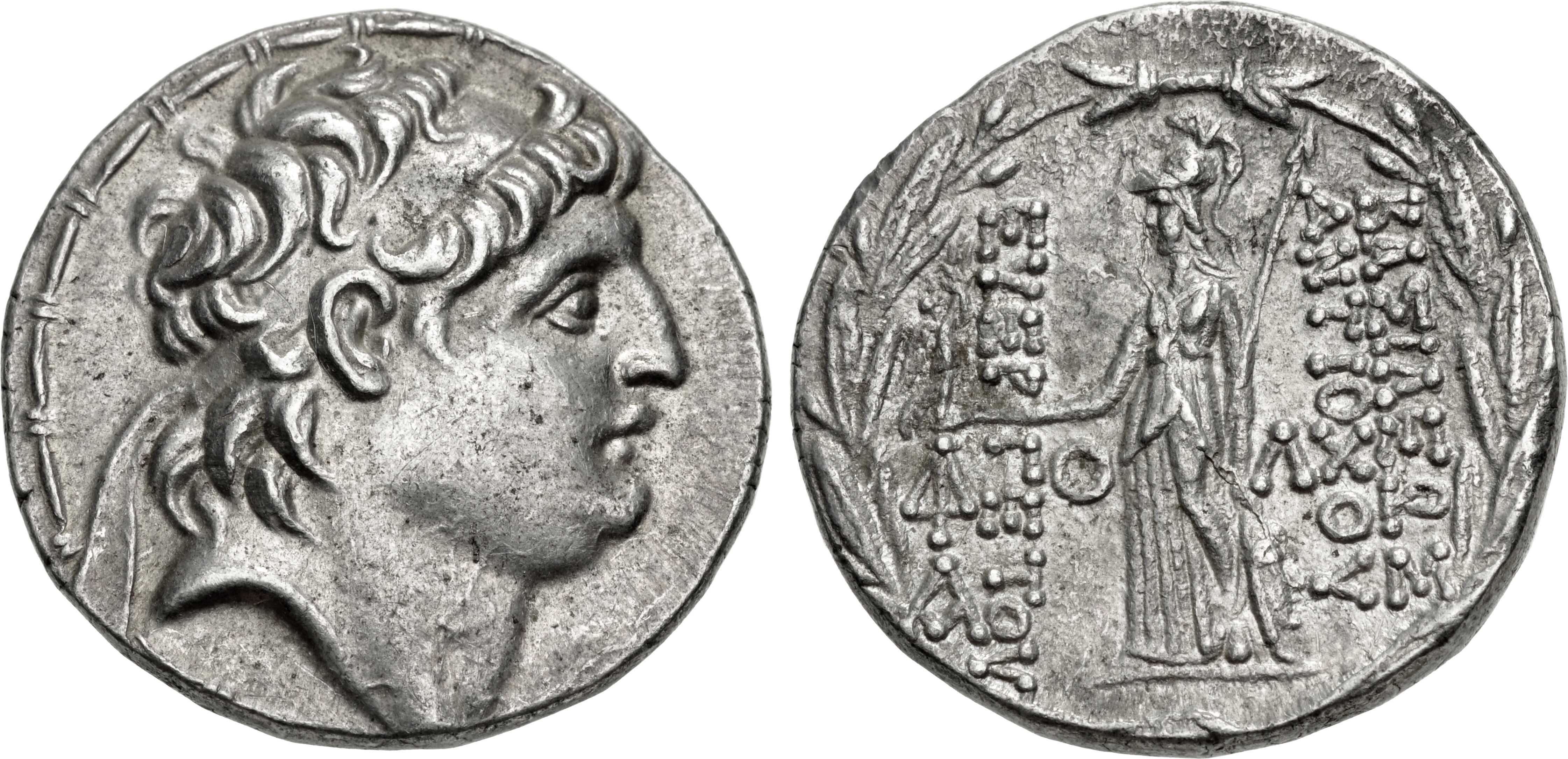Eusebeia (Ariarathes VII), silver, tetradrachms (Antiochus VII/Athena nicephorus) (107-100 BCE)
From SILVER
107 BCE - 100 BCE Silver 96,695 kg
Description
| ObverseInscription or printing placed on the obverse.: | |
| ReverseInscription or printing placed on the reverse.: | ΒΑΣΙΛΕΩΣ ΑΝΤΙΟΧΟΥ ΕΥΕΡΓΕΤΟΥ (Greek). |
Mint and issuing power
| MintIdentifies the place of manufacture or issue of a numismatic object.: | Eusebeia | Ancient regionAncient region.: | Cappadocia | Modern countryModern country: Turkey | AuthorityIdentifies the issuing power. The authority can be "pretended" when the name or the portrait of X is on the coin but he/she was not the issuing power. It can also be "uncertain" when there is no mention of X on the coin but he/she was the issuing power according to the historical sources: | Antiochus VII Euergetes (Seleucid king, 138-129 BC), Cappadocian kingdom, Ariarathes VII Philometor (king of Cappadocia, c. 116-c. 100 BC), Ariarathes VI (king of Cappadocia, c. 130-c. 114 BCE), Ariarathes VIII Eusebes Epiphanes (king of Cappadocia, c. 100-c. 95 BC) |
Chronology
| FromIdentifies the initial date in a range assigned in a numismatic context. | 107 BCE | toIdentifies the final date in a range assigned in a numismatic context.. | 100 BCE | PeriodTime period of the numismatic object.: Hellenistic 323-30 BC |
Physical description
| MetalThe physical material (usually metal) from which an object is made.: | Silver |
Median weightMedian of the weights of numismatic objects (in grams). in grams | 16.60 | DenominationTerm indicating the value of a numismatic object. Examples: tetradrachm, chalkous, denarius.: | tetradrachm |
StandardStandard.: |
Image

Cappadocia_Antiochus_VII.jpg [1]
References
| Die study referencePublication of the study: | Lorber - Houghton - Veselý 20061Lorber - Houghton - Veselý 2006, p. 86-97 (pas de catalogue). | ||
| Coin series referenceReference to coin series study: | |||
Obverse dies distribution
| FrequencyFrequency of specimen in distribution. ᵖ | Number of obversesNumber of obverse dies. ᵖ (o) | % (o) | Number of coinsNumber of coins. (n) | % (n) | Die nameName(s) of the die(s). |
| 1 | 110 | 54.19 | 110 | 22.77 | |
| 2 | 36 | 17.73 | 72 | 14.91 | |
| 3 | 19 | 9.36 | 57 | 11.8 | |
| 4 | 9 | 4.43 | 36 | 7.45 | |
| 5 | 8 | 3.94 | 40 | 8.28 | |
| 6 | 5 | 2.46 | 30 | 6.21 | |
| 7 | 4 | 1.97 | 28 | 5.8 | |
| 8 | 9 | 4.43 | 72 | 14.91 | |
| 9 | 1 | 0.49 | 9 | 1.86 | |
| 14 | 1 | 0.49 | 14 | 2.9 | |
| 15 | 1 | 0.49 | 15 | 3.11 | |
| Total | 203 of 203 | 99.98 | 483 of 483 | 100 |
Reverse dies distribution
no distribution is available
Quantification
| Number of obversesNumber of obverse dies. ᵖ (o) | 203 | Number of singletons (o1)The number of singleton coins. ᵖ | 110 |
| Number of reverse diesNumber of reverse dies. (r) | NC"NC" is not a number. | Number of coinsNumber of coins. (n) | 483 |
| Coins per obverse dieNumber of coins per obverse die. (n/o) | 2.38 | Coins per reverse dieNumber of coins per reverse die. (n/r) | |
| Reverse per obverse ratioRatio of obverse dies divided by reverse dies. (r/o) | Percentage of singletons (o1)number of coins (n) divided by the number of singletons (o1) ᵖ | 54.19 % | |
| Original number of dies (O) (Carter 1983 formula)The estimation of the number of coins according to Carter 1983 ᵖ | 291.25 | Coins struck if 20,000 as average productivity per dieCoins made if the average productivity for obverses (according to Carter) is 20,000. ᵖ | 5,825,000 |
| Original number of dies (O) (Esty 2011 formula)The estimation of the number of coins according to the singleton formula in Esty 2011 ᵖ (O) | 350.18 | Survival rate if 20,000 as average productivity per dieSurvival rate if average productivity is 20,000. ᵖ | 0.00008 |
| Coverage (o = % of O) (Esty 1984 formula)Esty 1984 - coverage (% of O) ᵖ (o = % of O) | 77.23% | Die productivity if survival rate 1/2,000Average productivity if survival rate is 1/2,000. ᵖ | 3,316.74 |
| Weight of silver (in kg) if 20,000 coins per die (O = Carter formula)Carter 1983 * Median weight * 20000 (*10 if gold or electrum) ᵖ | 96,695 kg <br /> 96,695 kg | Die productivity if survival rate 1/5,000Average productivity if survival rate is 1/5,000. ᵖ | 8,291.85 |
Remarks
Likely military
References
- ^ Lorber, Catherine C. - Houghton, Arhtur - Veselý, Petr (2006), "Cappadocian Tetradrachms in the Name of Antiochus VII. With an Appendix of quantitative analyses by Peter Vesely", Numismatic Chronicle 166, p. 65-75 (série 1).